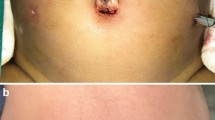Abstract
Single incision laparoscopic surgery as a surgical approach in treatment of pancreatic disease has recently been reported in adults. However, its application in persistent hyperinsulinemic hypoglycemia of infancy (PHHI) in children is limited. In this article, we report single incision laparoscopic 90 % pancreatectomy for the treatment of persistent hyperinsulinemic hypoglycemia of infancy. Between July 2011 and February 2015, the single incision laparoscopic 90 % pancreatectomy was performed in three children with PHHI. All patients underwent 18F-FDOPA PET/CT before the surgeries. The scans showed diffuse physiologic 18F-FDOPA activity in entire pancreas. All patients were followed up. The levels of blood sugar and insulin were recorded postoperatively. The time required for surgery was 120–230 min, and blood loss was minimal. The hospital stay was 6 days. The duration of postoperative abdominal drainage was 4–5 days. The levels of fasting blood glucose after surgery were higher than those before surgery (4.38–8.9 vs. 0.54–1.8 mmol/L). The levels of fasting insulin after surgery were lower than those before surgery (2.4–5.5 vs. 14–33.3 uU/ml). The duration of follow-up was 4–46 months. During follow-up, the levels of blood glucose and insulin were normal in three patients. There was no recurrence of hypoglycemia after operation in all patients. Single incision laparoscopic 90 % pancreatectomy for children with PHHI is feasible and safe in well-selected cases in the experienced centers.





Similar content being viewed by others
References
Dekelbab BH, Sperling MA (2006) Recent advances in hyperinsulinemic hypoglycemia of infancy. Acta Paediatr 95:1157–1164
Dunne MJ, Cosgrove KE, Shepherd RM et al (2004) Hyperinsulinism in infancy: from basic science to clinical disease. Physiol Rev 84:239–275
de Lonlay P, Fournet JC, Touati G et al (2002) Heterogeneity of persistent hyperinsulinaemic hypoglycaemia: a series of 175 cases. Eur J Pediatr 161:37–48
Bax NM, van der Zee DC, de Vroede M et al (2003) Laparoscopic identification and removal of focal lesions in persistent hyperinsulinemic hypoglycemia of infancy. Surg Endosc 17:833
Al- Shanafey S, Habib Z, Alnassar S (2009) Laparoscopic pancreatectomy for persistent hyperinsulinemic hypoglycemia of infancy. J Pediatr Surg 44:134–138
Bax KN, Van der Zee DC (2007) The laparoscopic approach toward hyperinsulinism in children. Semin Pediatr Surg 16:245–251
Mahachoklertwattana P, Suprasongsin C, Teeraratkul S et al (2000) Persistent hyperinsulinemic hypoglycemia of infancy: long-term outcome following subtotal pancreatectomy. J Pediatr Endocrinol Metab 13:37–44
Leibowitz G, Glaser B, Higazi AA et al (1995) Hyperinsulinemic hypoglycemia of infancy (nesidioblastosis) in clinical remission: high incidence of diabetes mellitus and persistent beta-cell dysfunction at long-term follow-up. J Clin Endocrinol Metab 80:386–392
Cherian MP, Abduljabbar MA (2005) Persistent hyperinsulinemic hypoglycemia of infancy (PHHI): long-term outcome following 95% pancreatectomy. J Pediatr Endocrinol Metab 18:1441–1448
McAndrew HF, Smith V, Spitz L (2003) Surgical complications of pancreatectomy for persistent hyperinsulinaemic hypoglycaemia of infancy. J Pediatr Surg 38:13–16
Meissner T, Wendel U, Burgard P et al (2003) Long-term follow-up of 114 patients with congenital hyperinsulinism. Eur J Endocrinol 149:43–51
Jack MM, Greer RM, Thomsett MJ et al (2003) The outcome in Australian children with hyperinsulinism of infancy: early extensive surgery in severe cases lowers risk of diabetes. Clin Endocrinol (Oxf) 58:355–364
Aynsley-Green A, Hussain K, Hall J et al (2000) Practical management of hyperinsulinism in infancy. Arch Dis Child Fetal Neonatal Ed 82:F98–F107
Raffel A, Krausch M, Anlauf M et al (2007) Diffuse nesidioblastosis as a cause of hyperinsulinemic hypoglycemia in adults: a diagnostic and therapeutic challenge. Surgery 141:179–184
Rahier J, Sempoux C, Fournet JC et al (1998) Partial or near-total pancreatectomy for persistent neonatal hyperinsulinaemic hypoglycaemia: the pathologist’s role. Histopathology 32:15–19
Suchi M, Thornton PS, Adzick NS et al (2004) Congenital hyperinsulinism: intraoperative biopsy interpretation can direct the extent of pancreatectomy. Am J Surg Pathol 28:1326–1335
Jack MM, Walker RM, Thomsett MJ et al (2000) Histologic findings in persistent hyperinsulinemic hypoglycemia of infancy: Australian experience. Pediatr Dev Pathol 3:532–547
Smith VV, Malone M, Risdon RA (2001) Focal or diffuse lesions in persistent hyperinsulinemic hypoglycemia of infancy: concerns about interpretation of intraoperative frozen sections. Pediatr Dev Pathol 4:138–143
Kauhanen S, Seppänen M, Minn H et al (2007) Fluorine-18-l-dihydroxyphenylalanine (18F-DOPA) positron emission tomography as a tool to localize an insulinoma or beta-cell hyperplasia in adult patients. J Clin Endocrinol Metab 92:1237–1244
Imperiale A, Sebag F, Vix M et al (2015) 18F-FDOPA PET/CT imaging of insulinoma revisited. Eur J Nucl Med Mol Imaging 42:409–418
Al-Shanafey S (2009) Laparoscopic vs. open pancreatectomy for persistent hyperinsulinemic hypoglycemia of infancy. J Pediatr Surg 44:957–961
Zhang JS, Li L, Diao M, Hou WY et al (2015) Single-incision laparoscopic excision of pancreatic tumor in children. J Pediatr Surg 50:882–885
Author information
Authors and Affiliations
Corresponding author
Ethics declarations
Conflict of interest
The authors declare that they have no conflict of interest.
Rights and permissions
About this article
Cite this article
Zhang, JS., Li, L. & Cheng, W. Single incision laparoscopic 90 % pancreatectomy for the treatment of persistent hyperinsulinemic hypoglycemia of infancy. Pediatr Surg Int 32, 1003–1007 (2016). https://doi.org/10.1007/s00383-016-3943-9
Accepted:
Published:
Issue Date:
DOI: https://doi.org/10.1007/s00383-016-3943-9




